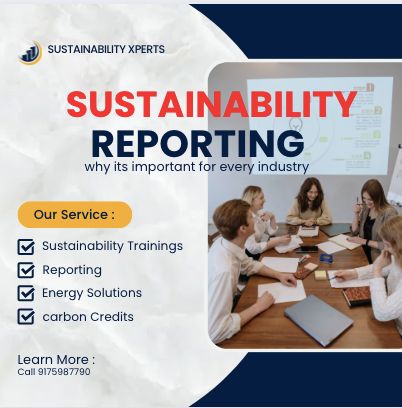Author – Neeraj Singh Rathore is a Sustainability Consultant, Personal Branding Coach, Business Coach and CII certified Carbon Credit practitioner. Worked with Infosys, Convergys and also best selling Author now working on reducing carbon emission and help in Sustainability Reporting. Email – neerajr@brandsalesacacademy.com.
Sustainability reporting is a type of non-financial reporting that helps businesses to communicate how they are doing in terms of goals and targets related to environmental, social, and governance metrics, as well as any current or potential risks or impacts. Driving specific actions towards initiatives is the main goal of sustainability reporting. Companies can define priorities and convey both the positive and negative effects of their actions on the economy, society, and environment by using sustainability reporting.
Photos, figures, charts, infographics, and other visual aids could be included in the reporting format to ensure total transparency when presenting the sustainability initiatives and progress. Long-term sustainability reporting helps businesses evaluate opportunities and risks, promote environmentally friendly operations, support corporate social responsibility initiatives, and create new business prospects.
What Information Belongs in a Sustainability Report?
Although there is no set style for sustainability reporting, it usually entails disclosing an organization’s ESG objectives and outlining its actions to date to achieve them. Sustainability reporting incorporates financial components in addition to ESG objectives. A company’s performance can be better understood by stakeholders, including investors, with the help of sustainability reporting, which goes beyond standard financial metrics.
Why Does Sustainability Reporting Exist?
In addition to helping a company discover opportunities and dangers that could affect its long-term success, sustainability reporting can also assist build a company’s reputation and increase transparency. Businesses that report on sustainability can lessen the effects of any ESG risks, save waste and save more money, make sure they are in compliance with regulations, and make better strategic choices.
A company’s sustainability report needs to show that it complies with all mandatory reporting requirements that may be in place. For example, the UK requires companies to report their annual greenhouse gas emissions, while the EU requires certain large companies to disclose information on social and environmental issues. Sustainability reports should adhere to a reliable set of standards, such SASB or GRI, in addition to legislative compliance, to guarantee accurate and consistent data and prevent greenwashing.
Which Sustainability Reporting Types Are There?
There are numerous varieties of sustainability reporting guidelines available. The Global Reporting Initiative (GRI), Sustainability Accounting Standards Board (SASB), Task Force on Climate-related Financial Disclosures (TCFD), and Carbon Disclosure Project (CDP) are a few of the most popular frameworks for reporting on sustainability and ESG issues.
Executives may find it difficult to choose which measures to use when reporting on the sustainability performance of their companies. While some businesses just disclose their greenhouse gas emissions, others use their ESG (environment, social, and governance) ratings or provide reports detailing their CSR (corporate social responsibility) initiatives.
Reporting requirements for sustainability
Sustainability reporting is the term used to describe the organised, regular information that businesses give the public about how they are doing.
• TCFD – Taskforce on Climate Related Disclosures; • CDSB – Climate Disclosure Standards Board; • GRI – Global Reporting Initiative; • IIRC – International Integrated Reporting Council; • SASB – Sustainability Accounting Standards Board;
Every standard covers a diverse range of topics, from those that are specific (like only focusing on greenhouse gas emissions) to those that are comprehensive (like covering all of ESG or all of the UN Sustainable Development Goals).
A crucial communication tool for the business’s stakeholders—consumers, staff members, shareholders, regulators, and the general public—is the sustainability report. It gives these stakeholders the knowledge they need to comprehend the company’s sustainability policies and procedures, evaluate its performance and risk in these areas, and base their own judgements and choices on this knowledge.
Some companies may be legally obligated to submit sustainability reports; this will depend on the company’s size, industry, location, and other factors. What Makes Businesses Write Sustainability Reports?
1. To start, a business can show its dedication to corporate responsibility and sustainability by using sustainability reporting. This can improve stakeholder relations, draw in new investors and partners, boost customer trust and loyalty, and enhance the company’s reputation.
2. Secondly, a company can manage and identify its sustainability-related risks and opportunities with the assistance of the process of creating a sustainability report. It can highlight operational, financial, reputational, and regulatory concerns pertaining to governance, society, and the environment, for instance.
3. Thirdly, a company’s strategic planning and decision-making processes can be enhanced by sustainability reporting. A business can establish and measure its sustainability goals, create more efficient and goal-oriented action plans, and have a better understanding of its strengths and weaknesses by gathering, analysing, and sharing information on its sustainability performance.
An organization’s sustainability efforts, outcomes, and objectives are presented in a clear and transparent manner in a well-written sustainability report, which is a crucial communication tool.
Below is a list of some of these crucial elements.
1. To begin with, a sustainability report ought to give a thorough overview of the company. This contains details on its goals, core principles, organisational structure, methods of operation, markets it serves, and the sustainability context in which it works. This section can answer queries like: What is the company’s scope of operations? In what location does it function? What is the organisational structure for sustainability management?
2. The organization’s methods for identifying, managing, and keeping an eye on opportunities and risks connected to sustainability should be transparent in the sustainability report. This covers risks and possibilities related to society (equity, inclusiveness, human rights), the environment (climate change, water scarcity, biodiversity loss), and governance (ethics, transparency, compliance).
3. Stakeholder Communication: The sustainability report should also include an explanation of the organization’s stakeholder relations and communication strategy.
Connect with us in case you need Sustainability training and also help in reporting.
#sustainability #sustainabilitymatters #environmentalsustainability #sustainabilityinstyle #selfsustainability #fashionsustainability #foodsustainability #makesustainabilitysexy #sustainabilityeducation #sustainabilityissexy #sustainabilityblogger #sustainabilitytips #sustainabilitygoals #socialsustainability #corporatesustainability #urbansustainability #ecosustainability #sustainabilityweek #sustainabilitystartswithyou #supportsustainability #sustainingsustainability #sustainabilitychallenge
